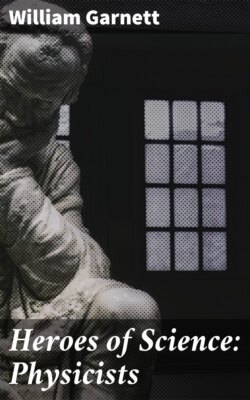Читать книгу Heroes of Science: Physicists - Garnett William - Страница 5
INTRODUCTION.
ОглавлениеThe dawn of true ideas respecting mechanics has been described in the volume of this series devoted to astronomers. At the time when the first of the following biographies opens there were a few men who held sound views respecting the laws of motion and the principles of hydrostatics. Considerable advance had been made in the subject of geometrical optics; the rectilinear propagation of light and the laws of reflection having been known to the Greeks and Arabians, whilst Willebrod Snellius, Professor of Mathematics at Leyden, had correctly enunciated the laws of refraction very early in the seventeenth century. Pliny mentions the action of a sphere of rock-crystal and of a glass globe filled with water in bringing light to a focus. Roger Bacon used segments of a glass sphere as lenses; and in the eleventh century Alhazen made many measurements of the angles of incidence and refraction, though he did not succeed in discovering the law. Huyghens developed to a great extent the undulatory theory; while Newton at the same time made great contributions to the subject of geometrical optics, decomposed white light by means of a prism, investigated the colours of thin plates, and some cases of diffraction, and speculated on the nature, properties, and functions of the ether, which was equally necessary to the corpuscular as to the undulatory theory of light, if any of the phenomena of interference were to be explained. The velocity of light was first measured by Roemer, in 1676. The camera obscura was invented by Baptista Porta, a wealthy Neapolitan, in 1560; and Kepler explained the action of the eye as an optical instrument, in 1604. Antonio de Dominis, Archbishop of Spalatro, discovered the fringe of colours produced by sunlight once reflected from the interior of a globe of water, and this led, in Newton's hands, to the complete explanation of the rainbow.
The germ of the mechanical theory of heat is to be found in the writings of Lord Bacon. The first thermometers which were blown in glass with a bulb and tube hermetically sealed, were made by a craftsman in Florence, in the time of Torricelli. The graduations on these thermometers were made by attaching little beads of coloured glass to their stems, and they were carried about Europe by members of the Florentine Academy, in order to learn whether ice melted at the same temperature in all latitudes.
In electricity the attraction of light bodies by amber when rubbed, was known at least six hundred years before the Christian era, and the shocks of the torpedo were described by Pliny and by Aristotle; but the phenomena were not associated in men's minds until recent times. Dr. Gilbert, of Colchester, Physician to Queen Elizabeth, may be regarded as the founder of the modern science. He distinguished two classes of bodies, viz. electrics, or those which would attract light bodies when rubbed; and non-electrics, or those which could not be so excited. The first electric machine was constructed by Otto von Guericke, the inventor of the Magdeburg hemispheres, who mounted a ball of sulphur so that it could be made rapidly to rotate while it was excited by the friction of the hand. He observed the repulsion which generally follows the attraction of a light body by an electrified object after the two have come in contact. He also noticed that certain bodies placed near to electrified bodies possessed similar powers of attraction to those of the electrified bodies themselves. Newton replaced the sulphur globe of Otto von Guericke by a globe of glass. Stephen Gray discovered the conduction of electricity, in 1729, when he succeeded in transmitting a charge to a distance of 886 feet along a pack-thread suspended by silk strings so as to insulate it from the earth. Desaguliers showed that Gilbert's "electrics" were simply those bodies which could not conduct electricity, while all conductors were "non-electrics;" and Dufay showed that all bodies could be electrified by friction if supported on insulating stands. He also showed that there were two kinds of electrification, and called one vitreous, the other resinous. Gray, Hawksbee, and Dr. Wall all noticed the similarity between lightning and the electric discharge. The prime conductor was first added to the electric machine by Boze, of Wittenberg; and Winkler, of Leipsic, employed a cushion instead of the hand to produce friction against the glass. The accumulation of electricity in the Leyden jar was discovered accidentally by Cuneus, a pupil of Muschenbroeck, of Leyden, about 1745, while attempting to electrify water in a bottle held in his hand. A nail passed through the cork, by which the electricity was communicated to the water. On touching the nail after charging the water, he received the shock of the Leyden jar. This brings the history of electrical discovery down to the time of Franklin.
